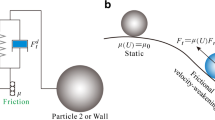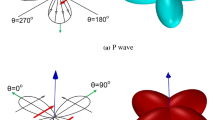Abstract
Landslide seismic signals support researchers to estimate magnitudes and locations of landslides. They can serve as a crucial data for landslide warning systems. However, the randomness of landslide locations makes the acquisition of landslide-induced seismic signals difficult and limits the number of available field data. The objectives of this study are to establish a numerical modeling approach to examine the characteristics of seismic signals induced by landslides and perform parametrical study. The two-dimensional particle flow code (PFC) and Fast Lagrangian Analysis of Continua (FLAC) are coupled to simulate the landslide process. The force and velocity data at the coupled interfaces of FLAC and PFC are transferred back and forth via a Socket I/O connection. Four locations were monitored for the induced vertical seismic signals, including velocity, acceleration, and stress histories. The signals were analyzed by Hilbert-Huang transform to obtain the time-frequency spectrograms for examining the characteristics of the signals. The particle size, wall friction, particle friction, and parallel bond of PFC input parameters were parametrically investigated. The Xiaolin landslide in 2009 was successfully simulated, and the characteristics of the seismic signals were studied and compared with the data from a broadband seismic station. These results demonstrate that terrain and transition in the movement type of a complex landslide do influence the seismic signals. A landslide with larger rock particles generates lower-frequency content seismic signals. Also, there can be approximately 40 s to escape before a large-scale landslide hits if seismic instrumentation is installed. The method proposed can be further applied for studies on many other large-scale rock avalanches to verify recorded signals and further correlate the signals with the landslide characteristics.

















Similar content being viewed by others
References
AnCAD, Inc (2012) Visual Signal Reference Guide, Version1.3. AnCAD, Inc. (in Chinese)
Cai M, Kaiser PK, Morioka H, Minami M, Maejima T, Tasaka Y, Kurose H (2007) FLAC/PFC coupled numerical simulation of AE in large-scale underground excavations. Int J Rock Mech Min Sci 44:550–564
Caudron M, Emeriault F, Kastner R, Al Heib M (2006) In: Schweiger HF (ed) Numerical modeling of the soil structure interaction during sinkholes, in Numerical methods in geotechnical engineering. Taylor and Francis Group, London, ISBN 0-415-40822
Chang KT, Lin ML, Dong JJ, Chien CH (2012a) The Hungtsaiping landslides: from ancient to recent. Landslides 9(2):205–214
Chang PY, Chen CC, Chang SK, Wang TB, Wang CY, Hsu SK (2012b) An investigation into the debris flow induced by Typhoon Morakot in the Siaolin Area, Southern Taiwan, using the electrical resistivity imaging method. Geophys J Int 188(3):1012–1024
Ekström G, Stark CP (2013) Simple scaling of catastrophic landslide dynamics. Science 339(6126):1416–1419
Feng ZY (2011) The seismic signatures of the 2009 Shiaolin landslide in Taiwan. Nat Hazards Earth Syst Sci 11:1559–1569
Feng ZY (2012) The seismic signatures of the surge wave from the 2009 Xiaolin landslide-dam breach in Taiwan. Hydrol Process 26(9):1342–1351
Giani GP, Migliazza M, Segalini A (1994) Experimental and theoretical studies to improve rock fall analysis and protection work design. Rock Mech Rock Eng 37:369–389
González E, Herreros MI, Pastor M, Quecedo M, Fernández Merodo JA (2002) Discrete and continuum approaches for fast landslide modeling. In: Numerical modeling in micromechanics via particle methods. Proceedings of the 1st International PFC Symposium, Gelsenkirchen, Germany, pp 307–313
Hoek E, Brown ET (1980) Underground excavations in rock. The Institution of Mining and Metallurgy, London
Huang NE, Shen Z, Long SR, Wu MC, Shih HH, Zheng Q, Yen NC, Tung CC, Liu HH (1998) The empirical mode decomposition and the Hilbert spectrum for nonlinear and nonstationary time series analysis. Phys Eng Sci 454:903–995, Proceedings of the royal society of London, series a: mathematical
Itasca Consulting Group, Inc (2011) Fast Lagrangian Analysis of Continua, Ver. 7.0 Manual. Itasca, Minneapolis
Itasca, Consulting Group Inc (2008) PFC2D particle flow code in 2 dimensions. In: Verification problem and example applications of Ver. 4.0 Manual. Itasca, Minneapolis
Liu ZN, Koyi HA (2013) Kinematics and internal deformation of granular slopes: insights from discrete element modeling. Landslides 10(2):139–160
Lo CM, Lin ML, Tang CL, Hu JC (2011) A kinematic model of the Hsiaolin landslide calibrated to the morphology of the landslide deposit. Eng Geol 123(1-2):22–39
Moretti L, Mangeney A, Capdeville Y, Stutzmann E, Huggel C, Schneider D, Bouchut F (2012) Numerical modeling of the Mount Steller landslide flow history and of the generated long period seismic waves. Geophys Res Lett 39:L16402
Petley D (2013) Characterizing giant landslides Science. Geophysics 339(6126):1395–1396
Potyondy DO, Cundall PA (2004) A bonded-particle model for rock. Int J Rock Mech Min Sci 41:1239–1364
Steven NW, Simon D (2006) Particulate kinematic simulations of debris avalanches: interpretation of deposits and landslide seismic signals of Mount Saint Helens, 1980 May 18. Int J Geophysics 167:991–1004
Tang CL, Hu JC, Lin ML, Angelier J, Lu CY, Chan YC, Chu HT (2009) The Tsaoling landslide triggered by the Chi-Chi earthquake, Taiwan: insights from a discrete element simulation. Eng Geol 106(1-2):1–19
Tommasi P, Campedel P, Consorti C, Ribacchi R (2008) A discontinuous approach to the numerical modelling of rock avalanches. Rock Mech Rock Eng 41(1):37–58
Tsou CY, Feng ZY, Chigira M (2011) Catastrophic landslide induced by Typhoon Morakot, Shiaolin, Taiwan. Geomorphology 127:166–178
Wu CH, Chen SC, Feng ZY (2013) Formation, failure, and consequences of the Xiaolin landslide dam, triggered by extreme rainfall from Typhoon Morakot, Taiwan. Landslides. doi:10.1007/s10346-013-0394-4
Yamada, M., Matsushi, Y., Chigira, M., and Mori, J. (2012) Seismic recordings of landslides caused by Typhoon Talas (2011), Japan. Geophys Res Lett 39.
Zhou J, Jin WF (2010) Coupled approach based numerical simulation of a retaining wall under seismic excitation. Rock Soil Mech 31(12):3949–3957
Zhou JW, Cui P, Fang H (2013) Dynamic process analysis for the formation of Yangjiagou landslide-dammed lake triggered by the Wenchuan earthquake, China. Landslides. doi:10.1007/s10346-013-0387-3
Acknowledgments
The authors appreciate the National Science Council of Taiwan in their support of this research under contract NSC99-2625-M-005-004-MY3. In addition, the authors would like to thank Dr. Ching-Ying Tsou for his help in preparation of Fig. 1.
Author information
Authors and Affiliations
Corresponding author
Rights and permissions
About this article
Cite this article
Feng, Zy., Lo, CM. & Lin, QF. The characteristics of the seismic signals induced by landslides using a coupling of discrete element and finite difference methods. Landslides 14, 661–674 (2017). https://doi.org/10.1007/s10346-016-0714-6
Received:
Accepted:
Published:
Issue Date:
DOI: https://doi.org/10.1007/s10346-016-0714-6




